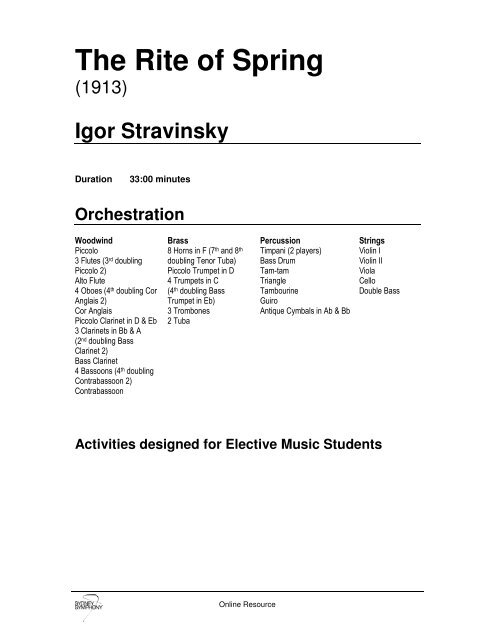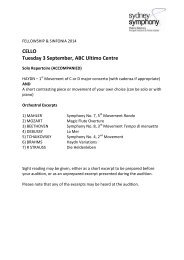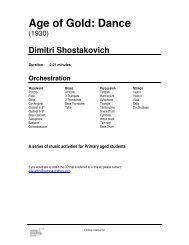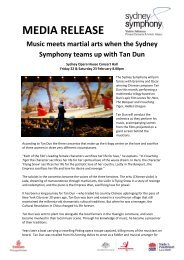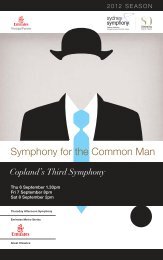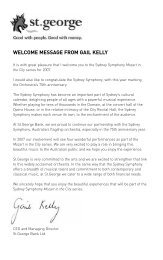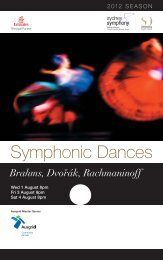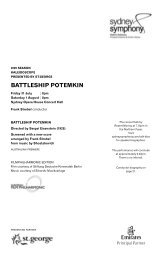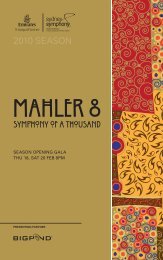The Rite of Spring - Sydney Symphony Orchestra
The Rite of Spring - Sydney Symphony Orchestra
The Rite of Spring - Sydney Symphony Orchestra
Create successful ePaper yourself
Turn your PDF publications into a flip-book with our unique Google optimized e-Paper software.
<strong>The</strong> <strong>Rite</strong> <strong>of</strong> <strong>Spring</strong><br />
(1913)<br />
Igor Stravinsky<br />
Duration 33:00 minutes<br />
<strong>Orchestra</strong>tion<br />
Woodwind<br />
Piccolo<br />
3 Flutes (3rd doubling<br />
Piccolo 2)<br />
Alto Flute<br />
4 Oboes (4th doubling Cor<br />
Anglais 2)<br />
Cor Anglais<br />
Piccolo Clarinet in D & Eb<br />
3 Clarinets in Bb & A<br />
(2nd doubling Bass<br />
Clarinet 2)<br />
Bass Clarinet<br />
4 Bassoons (4th doubling<br />
Contrabassoon 2)<br />
Contrabassoon<br />
Brass<br />
8 Horns in F (7th and 8th doubling Tenor Tuba)<br />
Piccolo Trumpet in D<br />
4 Trumpets in C<br />
(4th doubling Bass<br />
Trumpet in Eb)<br />
3 Trombones<br />
2 Tuba<br />
Online Resource<br />
Percussion<br />
Timpani (2 players)<br />
Bass Drum<br />
Tam-tam<br />
Triangle<br />
Tambourine<br />
Guiro<br />
Antique Cymbals in Ab & Bb<br />
Strings<br />
Violin I<br />
Violin II<br />
Viola<br />
Cello<br />
Double Bass<br />
Activities designed for Elective Music Students
Resources<br />
Use your school’s recording and score <strong>of</strong> Stravinsky’s <strong>Rite</strong> <strong>of</strong> <strong>Spring</strong> to assist you complete these classroom<br />
activities.<br />
Sound Excerpts<br />
<strong>The</strong> sound excerpts referred to in this resource are:<br />
Excerpt Bars Section<br />
Excerpt 1 1-14 First Part: Introduction<br />
Excerpt 2 1-71 Augurs <strong>of</strong> <strong>Spring</strong><br />
Excerpt 3 27-37 Ritual <strong>of</strong> Abduction<br />
Excerpt 4 1-42 <strong>Spring</strong> Rounds<br />
Excerpt 5 13-21 Procession <strong>of</strong> the Sage<br />
Excerpt 6 1-33 Sacrificial Dance<br />
Excerpt 7 34-92 Sacrificial Dance<br />
Excerpt 8 149-173 Sacrificial Dance<br />
Score Extracts<br />
Score extracts referred to are:<br />
Extract Bars Section<br />
Extract 1 1-14 First Part: Introduction<br />
Extract 2 1-71 Augurs <strong>of</strong> <strong>Spring</strong><br />
Extract 3 1-42 <strong>Spring</strong> Rounds<br />
Extract 4 13-21 Procession <strong>of</strong> the Sage<br />
Online Resource
Background<br />
Igor Stravinsky<br />
(1882-1971)<br />
Russian born Stravinsky was the son <strong>of</strong> a leading bass in St Petersburg. His<br />
early years until 1910 were spent in Russia absorbing influences from elder<br />
compatriots and others, including Rimsky-Korsakov, Tchaikovsky, Borodin,<br />
Glazunov, Debussy and Dukas. It was these influences Stravinsky carried when<br />
commissioned to compose for Diaghilev’s Ballets Russes in Paris: Firebird<br />
(1910), followed by Petrushka (1911) and <strong>The</strong> <strong>Rite</strong> <strong>of</strong> <strong>Spring</strong> (1913).<br />
Stravinsky moved to France in 1910 and remained there until 1939, except for<br />
the years <strong>of</strong> World War I which he spent in Switzerland. In the later part <strong>of</strong> his<br />
life he lived in the USA. He did not visit Russia again until 1962, although his<br />
music always bore a connection with his homeland.<br />
Serge Diaghilev<br />
(1872-1929)<br />
Diaghilev was the founder-director <strong>of</strong> the Ballets Russes. ‘Though not himself a dancer, choreographer,<br />
musician or designer, Diaghilev had as great an influence on the arts <strong>of</strong> his time as any primarily creative<br />
person. He was a true artistic director, not just an impresario as he is sometimes called. Through his<br />
knowledge and ambition he pushed the frontiers <strong>of</strong> taste towards a new and untried world’ 1 . As a student,<br />
he was part <strong>of</strong> a forward looking set <strong>of</strong> young intellectuals much influenced by Rimsky-Korsakov. He<br />
travelled to Paris where at first he became involved in the new world <strong>of</strong> French painting, honed his skills as<br />
an organiser and became editor <strong>of</strong> a new magazine. However, his roots were in the theatre. In 1908 he<br />
took the Imperial Opera to Paris. He planned a repeat tour in 1909. However, lack <strong>of</strong> money led to a<br />
season <strong>of</strong> ballet instead. This was the beginning <strong>of</strong> 25 years <strong>of</strong> innovation and achievement in theatre, ballet<br />
and music.<br />
<strong>The</strong> <strong>Rite</strong> <strong>of</strong> <strong>Spring</strong><br />
Music <strong>of</strong> the modern age is <strong>of</strong>ten dated from the historic and hysterical premiere <strong>of</strong> <strong>The</strong> <strong>Rite</strong> <strong>of</strong> <strong>Spring</strong> in May<br />
1913. <strong>The</strong>re were riots as members <strong>of</strong> the audience were either totally absorbed or totally abhorred by what<br />
they saw and heard. <strong>The</strong> composer Saint-Saëns reportedly yelled abuse, while Ravel defended Stravinsky<br />
as a genius. Debussy was in the middle, trying to get some quiet so the music could actually be heard,<br />
especially by the dancers. Stravinsky rushed out <strong>of</strong> the hall and back stage. ‘For the rest <strong>of</strong> the<br />
performance I stood in the wigs behind Nijinsky (the choreographer), holding the tails <strong>of</strong> his jacket while he<br />
stood on a chair shouting numbers to the dancers like a coxswain’. 2<br />
1 J.Drummond, ‘Dancing Revolution’, <strong>Sydney</strong> Morning Herald, 31 July-1 August, 2004<br />
2 From <strong>The</strong> Idiots Guide to Classical Music<br />
Online Resource
Stravinsky was completing Firebird in the spring <strong>of</strong> 1910 when he experienced a ‘vision’ <strong>of</strong> ‘a solemn pagan<br />
rite: wise elders, seated in a circle, watching a young girl dance herself to death. <strong>The</strong>y were sacrificing her<br />
to propitiate the god <strong>of</strong> spring.’ He collaborated with Nicholas Roerich, a set and costume designer, who<br />
was also a painter and an archaeologist well versed in folklore. Diaghilev gave his full support to the project<br />
and chose Vaslav Nijinsky to choreograph. However, Nijinsky could barely deal with the intricate rhythmic<br />
schemes, and so regardless <strong>of</strong> the ‘shocking new music’, the questionable footwork, together with the<br />
‘primitive’ costumes designed by Roerich, were enough to test any audience on opening night.<br />
Of the music, Harold Schonberg wrote: ‘Le Sacre’ with its metrical shiftings and shuttering force, its neartotal<br />
dissonance and breakaway from established canons <strong>of</strong> harmony and melody, was a genuine explosion.<br />
For decades there were repercussions, as composers all over the world imitated the new Stravinsky rhythms<br />
and sonorities’ 3 It is interesting to note, however, that Stravinsky never wrote in the same style again.<br />
<strong>The</strong> <strong>Rite</strong> <strong>of</strong> <strong>Spring</strong> is structured in two parts:<br />
First Part: Adoration <strong>of</strong> the Earth<br />
1. Introduction<br />
2. <strong>The</strong> Augurs <strong>of</strong> <strong>Spring</strong>: Dances <strong>of</strong> the Young Girls<br />
3. Ritual <strong>of</strong> Abduction<br />
4. <strong>Spring</strong> Rounds<br />
5. Ritual <strong>of</strong> the Rival Tribes<br />
6. Procession <strong>of</strong> the Sage<br />
7. <strong>The</strong> Sage<br />
8. Dance <strong>of</strong> the Earth<br />
Second Part: <strong>The</strong> Sacrifice<br />
1. Introduction<br />
2. Mystic Circles <strong>of</strong> the Young Girls<br />
3. Glorification <strong>of</strong> the Chosen One<br />
4. Evocation <strong>of</strong> the Ancestors<br />
5. Ritual Action <strong>of</strong> the Ancestors<br />
6. Sacrificial Dance (<strong>The</strong> Chosen One)<br />
Syllabus links<br />
<strong>The</strong> <strong>Rite</strong> <strong>of</strong> <strong>Spring</strong> by Igor Stravinsky covers a range <strong>of</strong> topics from the NSW syllabuses:<br />
Art Music <strong>of</strong> the 20 th and 21 st Centuries<br />
Music for Large Ensembles (Group 1)<br />
Music and the Related Arts<br />
Music <strong>of</strong> the 20 th and 21 st Centuries<br />
<strong>The</strong>atre Music<br />
Music 1900-1945<br />
3 H. Schonberg<br />
Online Resource
Analysis<br />
First Part: Adoration <strong>of</strong> the Earth<br />
Introduction<br />
Bar Features<br />
1-38 • Lento tempo rubato<br />
• A penetrating solo bassoon in high register plays a fragment <strong>of</strong> a Lithuanian folk tune.<br />
• Rubato and ad lib markings along with fermata, mixed metre and irregular rhythmic<br />
groupings give a sense <strong>of</strong> freetime improvisation.<br />
• Woodwinds, violins and horns join the bassoon with repeated fragments <strong>of</strong> there own.<br />
39-65 • A sense <strong>of</strong> metred time provided by a triplet <strong>of</strong>fbeat ostinato in solo cello.<br />
• Addition <strong>of</strong> more layers in the form <strong>of</strong> woodwind, brass and string fragments as the<br />
music builds to a piercing climax.<br />
66-75 • Sudden silence followed by a return <strong>of</strong> the solo bassoon.<br />
• Pizzicato violins introduce a repeated 4 note figure based on a minor 3rd and Perfect<br />
4th in anticipation <strong>of</strong> what is to come.<br />
<strong>The</strong> Augurs <strong>of</strong> <strong>Spring</strong>: Dances <strong>of</strong> the Young Girls<br />
Bar Features<br />
1-42 • Tempo giusto<br />
• Percussive, dissonant string ostinato – forte, staccato, down bow, double stopped,<br />
polychord. Lower strings play an Fb (E) major chord against Eb7 in the violins and<br />
violas. Displaced accents emphasised by jabbing chords by the eight horns.<br />
• A succession <strong>of</strong> melodic fragments in woodwinds and brass follow, beginning with the<br />
cor anglais playing the 4-note figure played by the violins at the end <strong>of</strong> the first section.<br />
• Simultaneous use <strong>of</strong> contrasting articulations in similar instruments, eg pizzicato vs.<br />
arco, legato vs. flutter tonguing.<br />
• Muted brass chords built on the Perfect 5th in Bars 26, 28 and 29.<br />
43-71 • New bassoon theme enters over sub p string ostinato.<br />
• Contrasting high flute grace note figure.<br />
• General pause – pizzicato string chord, brass chord, descending triplet figure by<br />
timpani and lower strings, then tuba fermata.<br />
72-172 • Immediately contrasting grace note figures descend through woodwinds with return to<br />
various melodic fragments.<br />
• New horn theme is introduced.<br />
• Texture builds with continued rhythmic excitement.<br />
• New trumpet theme introduced at Bar 119. <strong>The</strong> trumpets play in parallel major 3rds<br />
and Perfect 4ths.<br />
Online Resource
Ritual Abduction<br />
Bar Features<br />
1-66 • Presto<br />
• Frenzy grows out <strong>of</strong> previous section.<br />
• Violent strokes on timpani and bass drum.<br />
• Powerful accents and rapid changes <strong>of</strong> metre.<br />
• Closing high flute trill leads to next section.<br />
<strong>Spring</strong> Rounds<br />
Bar Features<br />
1-6 • Tranquillo<br />
• Flute trills over clarinet theme.<br />
• Note changes <strong>of</strong> metre.<br />
7-54 • Sostenuto e pesante<br />
• Ponderous ostinato in strings with half the violas, the cellos and bass clarinet<br />
on the <strong>of</strong>f beat.<br />
• Violins and horns return to trumpet theme from second section.<br />
• Becomes increasingly aggressive as dynamics and texture build.<br />
• Increased use <strong>of</strong> heavy accents and dissonance.<br />
55-62 • Tranquillo<br />
• Clarinet theme returns doubled by alto flute.<br />
Ritual <strong>of</strong> the Rival Tribes<br />
Bar Features<br />
1-74 • Molto Allegro<br />
• Three contrasting ideas.<br />
• Trombones, tuba and timpani play short motives based on minor 2nds,<br />
diminished 5ths and major 7th.<br />
• <strong>The</strong>me in the horns is stated a number <strong>of</strong> times with slight variations.<br />
• Woodwinds introduce a third legato idea at Bar 23.<br />
• Texture and dynamics build with accents interspersed.<br />
• At Bar 63 the strings and woodwinds return to the third idea. <strong>The</strong> tubas super<br />
impose a new melodic ostinato in anticipation <strong>of</strong> the next section.<br />
• Sustained horn notes create dissonance against the two ideas.<br />
Online Resource
Procession <strong>of</strong> the Sage<br />
Bar Features<br />
1-21 • Texture continues from the end <strong>of</strong> the previous section.<br />
• Pulsating quaver motives in the bassoons, lower strings and timpani involving dissonant<br />
melodic and harmonic intervals – 2nds, 7ths, 9ths, diminished 5ths.<br />
• Tuba melodic ostinato and sustained horn notes continue.<br />
• Texture and dynamics build with the addition <strong>of</strong> woodwind ostinatos.<br />
• Rhythmically complex from Bar 13 with cross rhythms and a polymetric effect achieved<br />
through use <strong>of</strong> accents, ties, groupings <strong>of</strong> 2 and 3, duplets and quadruplets.<br />
• Silence.<br />
<strong>The</strong> Sage<br />
Bar Features<br />
1-4 • Lento<br />
• Bassoons and one contrabassoon play a s<strong>of</strong>t sustained chord cluster.<br />
• Second contrabassoon, timpani and muted double bass play a quaver pulse on beats 2 and 4.<br />
• A short respite from the surrounding frenzy concludes with a ppp string harmonic cluster.<br />
Dance <strong>of</strong> the Earth<br />
Bar Features<br />
1-60 • Prestissimo<br />
• Timpani triplets begin a fast and furious series <strong>of</strong> repeated accented chords, short motives,<br />
rhythmic ostinatos and glissandos.<br />
• Rhythmic intensity and dynamics build to finish the first part.<br />
Second Part: <strong>The</strong> Sacrifice<br />
Introduction<br />
Bar Features<br />
1-18 • Largo<br />
• Exploration <strong>of</strong> various colours and sonorities.<br />
• Metric ambiguity as the time shifts between 3, 4 and 2.<br />
• Horns sustain a D minor chord over which the woodwinds pulsate between a D# minor and C#<br />
minor.<br />
• String motives using various techniques including harmonics, over the finger board, on the<br />
bridge<br />
• Rising and falling scalic motives in contrary motion become a feature.<br />
19-36 • <strong>The</strong> alto flute and solo violin introduce a new theme.<br />
37-61 • Time shifts to 5 and 6.<br />
• Ties across the beat in one <strong>of</strong> two trumpet parts create a cross rhythm.<br />
• Contrasting percussive motive provided by the strings.<br />
• Horns and strings close the section with a statement <strong>of</strong> the earlier theme and the trumpet’s<br />
cross rhythm idea.<br />
Online Resource
Mystic Circles <strong>of</strong> the Young Girls<br />
Bar Features<br />
1-64 • Andante con moto<br />
• Violins open with the theme from the introduction which is extended. Note the ambiguous<br />
harmony as both the major and minor thirds <strong>of</strong> the triad are used simultaneously.<br />
• Alto flute introduces a new folk like theme before it is passed to various woodwind and string<br />
colours, and later the horns.<br />
• Pizzicato lower strings return to a syncopated ostinato.<br />
• Muted brass lead a crescendo and accelerando up to a bar <strong>of</strong> 11 beats <strong>of</strong> timpani and down<br />
bow strings playing a repeated cluster.<br />
Glorification <strong>of</strong> the Chosen One<br />
Bar Features<br />
1-58 • Vivo<br />
• Changing metre.<br />
• Shifting accents.<br />
• Mixed note groupings.<br />
• Syncopated ostinatos.<br />
• Flourishes and bursts <strong>of</strong> colour.<br />
• Various colours and techniques used – glissando, pizzicato, flutter tonguing, mutes.<br />
Evocation <strong>of</strong> the Ancestors<br />
Bar Features<br />
1-42 • General pause.<br />
• Timpani motive and bass clarinet and lower string pedal.<br />
• Woodwinds and brass play a fanfare-like theme.<br />
• Shifting accents and changing metre.<br />
• Contrast in colour towards the end <strong>of</strong> the short section as bassoon presents the theme.<br />
Ritual Action <strong>of</strong> the Ancestors<br />
Bar Features<br />
1-14 • Pizzicato strings and horns play a s<strong>of</strong>t chord cluster ostinato on the beat with timpani and<br />
tambourine on the <strong>of</strong>f beat.<br />
• Cor anglais and alto flute motives.<br />
14-51 • Rolling semiquavers played by the alto flute.<br />
• Bassoon quaver ostinato minor 6th.<br />
• Cor anglais pedal on the beat with viola <strong>of</strong>f the beat.<br />
• Muted trumpets introduce new theme.<br />
• Short muted tremolo string motives follow the theme.<br />
• Fortissimo tutti as horns present the theme against accented dissonant trumpet chords.<br />
• Dynamics reduce as a series <strong>of</strong> short motives are presented.<br />
• Return to tutti accented ostinato accompaniment as the theme is presented a third time fff by<br />
the horns.<br />
Online Resource
Bar Features<br />
52-66 • Return to opening idea, but with bass trumpet replacing the cor anglais.<br />
• Bass clarinet brings the section to a close.<br />
Sacrificial Dance (<strong>The</strong> Chosen One)<br />
Bar Features<br />
1-33 Section A<br />
• Changing metre.<br />
• Irregular accents.<br />
• Harsh dissonance.<br />
• Harsh articulation and dynamics – horns marked sempre cuivre.<br />
• Percussive orchestration.<br />
• Organised symmetrically around recurring 3 semiquaver motive.<br />
34-115 Section B<br />
• Sudden drop in dynamics.<br />
• Changing metre continues with irregularly grouped ostinatos in rhythmic unison across<br />
bassoons, horns and string.<br />
• Contrasting forte quintuplet motive in brass.<br />
• Ostinato builds to fortissimo and tutti.<br />
116-148 Section A 1<br />
149-173 Section C<br />
• Lower instruments - contrabassoon, tuba, cellos, double basses and percussion play<br />
ostinatos.<br />
• Rhythmic, low register horn pedal.<br />
• New motive.<br />
174-180 Section A 2<br />
181-202 Section C<br />
203-275 Section A 3<br />
Online Resource
Musicology<br />
• Translate the French names <strong>of</strong> the orchestration <strong>of</strong> <strong>The</strong> <strong>Rite</strong> <strong>of</strong> <strong>Spring</strong> into English.<br />
• Give the abbreviation for each instrument (refer to the Score Extracts).<br />
• Explain the transposition for each instrument. (Some answers are given.)<br />
French English Translation Abbreviation Transposition<br />
3 Flauti grandi<br />
Fl.gr<br />
Flauto piccolo<br />
Flauto alto<br />
4 Oboi<br />
Corno inglese<br />
Clarinetto piccolo in Re e Mi b<br />
3 Clarinetti in Si b e La<br />
4 Fagotti<br />
Contrafagotto<br />
8 Corni in Fa<br />
4 bassoons<br />
Online Resource<br />
Sounds as written<br />
Tromba piccola in Re Sounds major 2nd higher than<br />
written<br />
4 Trombe in Do<br />
3 Tromboni<br />
2 Tube bassi<br />
Timpani (2 esecutori)<br />
Batteria: Gran cassa<br />
Tam-tam<br />
Triangolo<br />
Tamburo di Basque<br />
Guero<br />
Piatti antichi in La b e Si b<br />
Archi<br />
Not applicable
Composition<br />
1. Experiment with the white notes <strong>of</strong> the keyboard to construct a six note scale.<br />
For example, degrees <strong>of</strong> the scale could be:<br />
or<br />
1 2 3 5 6 7 (1)<br />
1 2 3 4 5 6 (1)<br />
2. Improvise a melodic shape in free time using the scale.<br />
3. Vary the length <strong>of</strong> the phrases.<br />
4. Select a ‘home note’ on which to end each phrase (need not be ‘1’).<br />
5. (a) Experiment by adding an accidental to one note <strong>of</strong> the scale.<br />
(b) Use this new version <strong>of</strong> the scale to extend the melody a little further.<br />
(c) What effect does this note have on the melody? Does it alter the mood?<br />
6. (a) Notate the melody.<br />
(b) Maintain the effect <strong>of</strong> an improvised melody in free time by changing time signatures and using<br />
irregular note groupings, ties, fermatas and so on.<br />
Online Resource
Musicology/Aural<br />
Online Resource<br />
First Part: Introduction<br />
Sound Excerpt 1<br />
Score Extract 1<br />
Bars 1-14<br />
Listen to Sound Excerpt 1 while following Score Extract 1 and answer the following questions.<br />
1. <strong>The</strong> opening <strong>of</strong> <strong>The</strong> <strong>Rite</strong> <strong>of</strong> <strong>Spring</strong> has an improvised free time feel. List the ways Stravinsky has<br />
achieved this with reference to duration and expressive techniques.<br />
2. How has Stravinsky used tone colour to attract the listener’s attention in the opening?<br />
3. (a) Describe the melody.<br />
(b) Comment on the structure <strong>of</strong> the melody.
Aural/Performance<br />
1. (a) Mark the quavers that are normally accented in 2 4 time.<br />
(b) Perform this rhythm on classroom percussion instruments:<br />
• wooden instruments play the quaver pulse with the marked accents;<br />
• drums play only the accented notes.<br />
Online Resource<br />
<strong>The</strong> Augurs <strong>of</strong> <strong>Spring</strong><br />
Sound Excerpt 2<br />
Bars 1-71<br />
2. (a) Listen to Bars 1-8 <strong>of</strong> Sound Excerpt 2, CD cue 0:00-0:09, and indicate where Stravinsky has<br />
placed the accents.<br />
(b) Perform the rhythm on classroom percussion instruments:<br />
• wooden instruments play the quaver pulse with the marked accents;<br />
• drums play only the accented notes.<br />
(c) Perform the rhythms with Bars 1-8 <strong>of</strong> Sound Excerpt 2.
Aural/Musicology<br />
Online Resource<br />
<strong>The</strong> Augurs <strong>of</strong> <strong>Spring</strong><br />
Sound Excerpt 2<br />
Score Extract 2<br />
Bars 1-71<br />
Listen to Sound Excerpt 2 while following Score Extract 2 and answer the following questions.<br />
A polychord is where two or more chords are combined to make a more complex chord.<br />
1. <strong>The</strong> chord that Stravinsky repeats in Bars 1-8 is an example <strong>of</strong> a polychord.<br />
(a) Notate the chords played by the cello/double bass and the violin/viola in the table below.<br />
(b) Identify the two chords that are combined to make the polychord.<br />
Cello/Double Bass Chord Violin/Viola chord<br />
Chord: Chord:<br />
A tone-cluster is a chord that is used to create a physical and psychological impact. <strong>The</strong> sounds combined<br />
are irrelevant as ‘pitch’, eg large ‘clusters’ built in 2nds have this effect.<br />
2. Discuss whether Stravinsky intended the chord above to be a tone cluster or a polychord.<br />
3. Identify the intervals used in the cor anglais ostinato in Bars 9-12.<br />
4. Comment on the broken chords in the bassoon and cello parts in Bars 9-12.<br />
5. Describe the playing techniques used by the strings in Sound Excerpt 2.<br />
6. Comment on the role <strong>of</strong> the trumpet, oboes and violin I in Bars 18-22.
7. In Bars 26 and 28-29 the muted trumpets and horn 4 repeat a chord that has an unusual structure.<br />
(a) Write the notes <strong>of</strong> the chord in order from lowest to highest. (Remember to transpose the<br />
trumpet in D and the horn in F to actual pitch.)<br />
(b) Comment on the way this chord is structured.<br />
8. (a) Which instrument(s) have the melodic interest after Bar 43?<br />
(b) How has Stravinsky ensured the melody is not overpowered by the accompaniment?<br />
9. Transpose the trombone part from Bars 65-67 to sounding pitch.<br />
10. (a) Describe how Stravinsky has treated the melodic material in Bars 60-69.<br />
(b) What compositional device has he used?<br />
Online Resource
Performance<br />
Online Resource<br />
Ritual <strong>of</strong> Abduction<br />
Sound Excerpt 3<br />
Bars 27-37<br />
1. (a) Perform the rhythm from Sound Excerpt 3 which contains changing metres below:<br />
• Say the counts written under the notes, emphasising every ‘1’.<br />
• Perform the rhythm on percussion instruments with strong accents.<br />
2. Perform the rhythm with Sound Excerpt 3.
Aural/Composition/Musicology<br />
Online Resource<br />
<strong>Spring</strong> Rounds<br />
Sound Excerpt 4<br />
Score Extract 3<br />
Bars 1-42<br />
1. (a) Listen to Bars 1-6 <strong>of</strong> Sound Excerpt 4 several times and notate the melody below.<br />
(b) Check your answer from the score remembering to transpose the part to sounding pitch.<br />
2. Harmonise the melody. Experiment with devices such as drones and parallel motion at the intervals<br />
<strong>of</strong> a 2nd, 3rd, 4th, 5th, 6 th and 7th.<br />
An ostinato pattern which sets up a strong, heavy pulse begins at Bar 7 <strong>of</strong> <strong>Spring</strong> Rounds. Listen to Sound<br />
Excerpt 4 from Bar 7 while following Score Extract 3 and answer the following questions.<br />
3. Identify performance directions from the score that create the heavy feeling <strong>of</strong> the music.<br />
4. <strong>The</strong>re are two other reasons for this heavy, dragging quality: frequent use <strong>of</strong> parallel 5ths and a<br />
syncopated ostinato rhythm that drags behind the beat.<br />
(a) Identify the instruments that play in 5ths.<br />
(b) Notate the one bar rhythm pattern <strong>of</strong> the ostinato.<br />
5. At Bar 17 the theme and harmony parts in rhythmic unison are played above the ostinato<br />
accompaniment patterns.<br />
(a) Identify the instruments that play the melody/harmony in the first phrase.<br />
(b) Identify the intervals used in the parallel motion <strong>of</strong> the harmony.<br />
(c) What is the interval between the two inner parts? What is the effect <strong>of</strong> this interval?<br />
6. Discuss the similarities and differences between Bars 15-31 and Bars 32-42.
Performance/Musicology<br />
Online Resource<br />
Procession <strong>of</strong> the Sage<br />
Sound Excerpt 5<br />
Score Extract 4<br />
Bars 13-21<br />
This excerpt features polyrhythm and cross rhythms. Rhythms <strong>of</strong> different metres and in some cases<br />
tempos are combined although they are all notated in 6 4.<br />
Part 1 (effectively 4 4 because <strong>of</strong> rhythm):<br />
Part 2 (2 bar ostinato effectively in 4 4):<br />
Part 3 (grouped normally in 6 4 - compound duple time):<br />
Part 4 (grouped in 12 8 - compound quadruple time):<br />
Part 5 (quaver quadruplets produces 4 4, but at a slower tempo):<br />
Part 6 (crotchet duplets produces 4 4 at an even slower tempo than Part 5):<br />
1. Learn to play the rhythms:<br />
• Perform each line separately, emphasising the accents;<br />
• Perform two parts together, eg Parts 5 and 6; Parts 1 and 2; Parts 4 and 6 and so on;<br />
• Try playing the more difficult pairings, eg Parts 4 and 5 and Parts 3 and 5;<br />
• Perform the rhythms with Sound Excerpt 7.
Composition<br />
Stravinsky used unusual pitch devices including:<br />
• tone clusters<br />
• polychords<br />
• polytonality<br />
1. Experiment with each device, notating ideas that sound most effective.<br />
2. Experiment with applying different tone colours to each device. Evaluate their effect on the sound<br />
and mood.<br />
• same or similar instruments;<br />
• contrasting colours;<br />
• different registers;<br />
• different playing techniques, eg pizzicato, arco, harmonics, flutter tonguing, flautando, sul<br />
ponticello and so on<br />
• different combinations <strong>of</strong> all <strong>of</strong> the above.<br />
3. Notate your ideas and use them as the basis <strong>of</strong> a short composition.<br />
Online Resource
Aural<br />
Online Resource<br />
Sacrificial Dance<br />
Sound Excerpt 6<br />
Bars 1-33<br />
Sound Excerpt 7<br />
Bars 34-92<br />
Sound Excerpt 8<br />
Bars 149-173<br />
Sacrificial Dance is in rondo form. Listen to the three contrasting sections (Sound Excerpts 6-8) and<br />
describe the features <strong>of</strong> each section with reference to the concepts <strong>of</strong> music.<br />
Section Musical Features<br />
A (Sound Excerpt 6)<br />
B (Sound Excerpt 7)<br />
C (Sound Excerpt 8)
Resources<br />
Stravinsky<br />
www.teachnet.ie/adonaghermcgowan/listresp/stravinsky.html<br />
www.teachersparadise.com/ency/en/wikipedia/i/ig/igor-stravinsky.html<br />
www.artsalive.ca/en/mus/greatcomposers/stravinsky.html<br />
Film<br />
http://www.rhythmisit.de/php/index_flash.php<br />
http://www.rhythmisit.de/php/index_n<strong>of</strong>lash.php<br />
http://www.german-cinema.de/archive/film_view.php?film_id=1104<br />
Related Arts<br />
www.ncmoa.org/matisse/lessons/activities/activities3.html<br />
Online Resource


